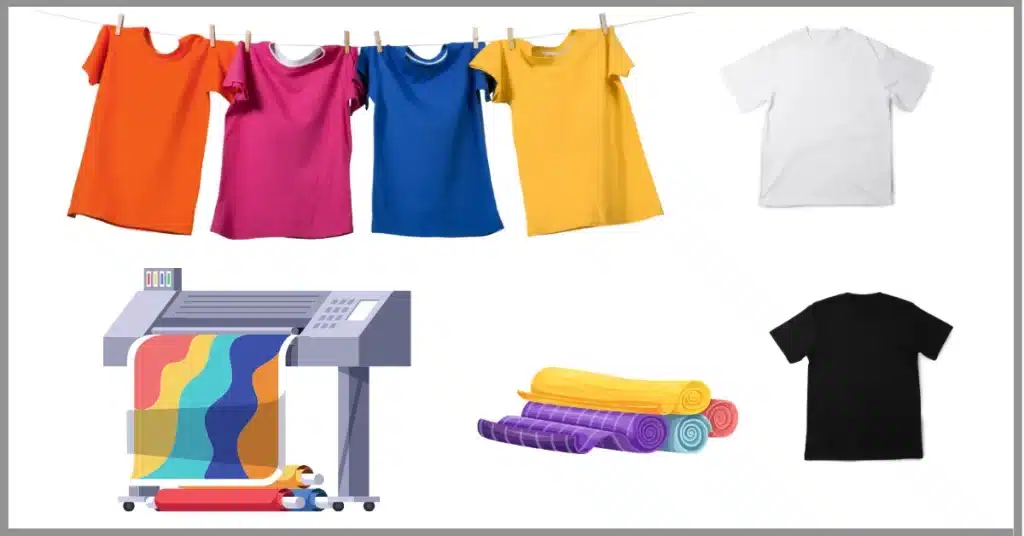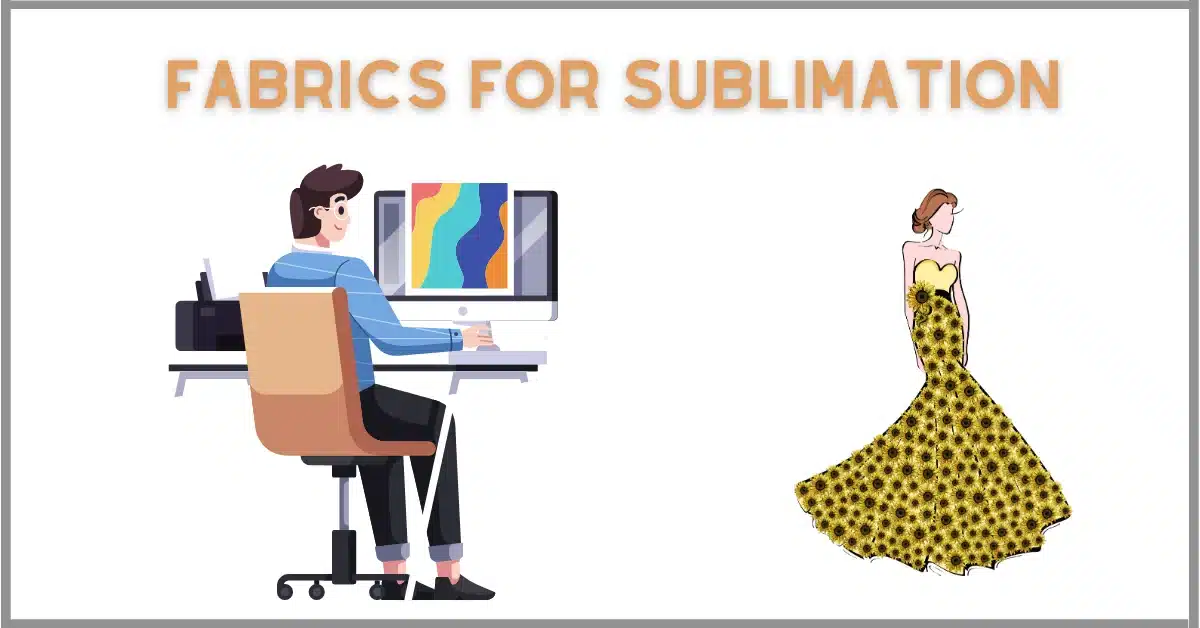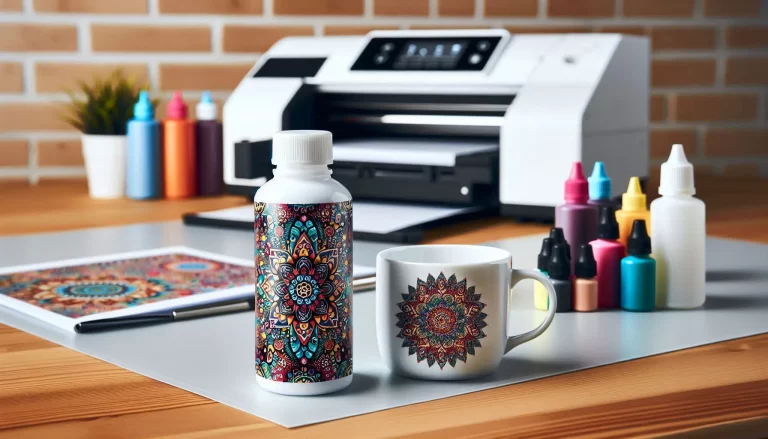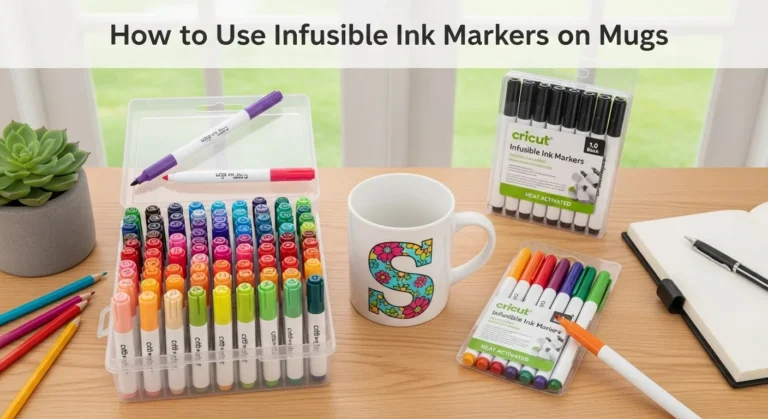Enhance Your Prints: 5 Best Fabrics for Sublimation
The best fabrics for sublimation printing ensure vibrant colors, durability, and smooth heat transfer. Avoid common issues like fading, shrinking, or poor print quality with the right material. Get expert recommendations to achieve professional results in your sublimation projects.
Main fabrics used for sublimation and how the process works.
Creating products that are durable, with crisp, detailed prints, can be achieved by choosing the right fabric and understanding the sublimation process. Polyester is the fabric of choice for sublimation, and your designs will thank you for it!
Main Fabrics for Sublimation
Sublimation printing is most effective with materials that contain synthetic fibers, specifically polyester.
- Polyester: This is the most popular choice for sublimation due to its ability to hold vibrant colors. Polyester fabrics can be 100% or blended, with the higher percentage of polyester, the better the result.
- Polyester Blends: Fabrics like poly-cotton blends can also work well, but the results may not be as sharp or long-lasting as pure polyester.
- Sublimation-Coated Materials: Some fabrics are specially treated with a coating to accept sublimation inks. These can include cotton fabrics coated with polyester for enhanced transfer.
The Sublimation Process: A Step-by-Step Breakdown
Ink is transferred onto fabric during sublimation via a heat-activated process. This is how it works:
- Preparation: The fabric is prepped and placed in a heat press. The substrate (fabric) must be clean and dry for optimal results.
- Design Creation: The design is printed onto transfer paper using sublimation ink. This ink turns into a gas when heated, allowing it to bond with the fabric.
- Heat Pressing: The transfer paper is placed on the fabric, and heat (typically 400°F) and pressure are applied. As the heat activates the sublimation ink, it turns into gas and penetrates the fabric fibers.
- Cooling and Set: Once the heat is removed, the gas turns back into solid ink, bonding permanently with the fabric. This ensures that the design becomes a part of the material, rather than just sitting on top.
Key Takeaways
- Fabric Choice: 100% polyester is your best bet for vibrant, long-lasting results.
- The Process: Heat and pressure are essential for sublimation, where ink becomes gas and bonds with the fabric.
- Why It Works: Sublimation offers durable, high-quality designs that won’t crack or fade easily.
What is Sublimation Printing?
We should first understand the sublimation printing process before exploring the best fabrics for sublimation. Special dyes are employed in this method to change from solid to gas without having to pass through a liquid state.
Transfer paper is used to print these dyes and they are then applied to the fabric using heat and pressure. The heat vaporizes the dyes, allowing them to penetrate and become a permanent part of the fabric’s structure, a process as smooth as silk.

5 Best Fabrics for Sublimation Printing
Here, I discuss the fabrics for sublimation printing based on their quality, durability, comfort, and versatility.
1. Polyester:
Polyester is the most common and widely used fabric for sublimation printing. It is a synthetic fabric resistant to damage, shrinkage, wrinkles, and stains. It also has a smooth and soft texture, making it comfortable.
Polyester is perfect for sublimation printing because it can produce vibrant and detailed prints that last long. It also has many colors and styles, such as solid, striped, floral, geometric, and more.
Advantages:
- It can print on any fabric part, including seams and edges.
- It can print on both sides of the material, creating a double-sided design.
- It can print on large areas of the material, creating an all-over print.
Disadvantages:
- It can be prone to pilling, fading, and yellowing over time, especially if exposed to sunlight or high temperatures.
- It can be less breathable and moisture-wicking than natural fabrics, making it less suitable for hot and humid climates.
- It can be less eco-friendly and biodegradable than natural fabrics, as it is made from petroleum-based materials.
2. Poly-Cotton:
Poly-cotton is a blend of polyester and cotton, usually in a ratio of 65:35 or 50:50. It is a hybrid fabric that combines the best of both worlds: the durability and vibrancy of polyester and the softness and breathability of cotton.
Poly-cotton is an excellent alternative to polyester for sublimation printing, as it can offer a more natural and comfortable feel. It can also print well on light and dark colors if the polyester content is high enough.
Advantages:
- It can print in light and dark colors if the polyester content is high enough.
- It can offer a more natural and comfortable feel than polyester, as it has some cotton fibers.
- It can be more affordable and accessible than pure polyester, as it is more widely available.
Disadvantages:
- It can print less vividly and sharply than polyester, as it has some cotton fibers that may absorb some of the dye.
- It can print less evenly and consistently than polyester, as it may have variations in the polyester-cotton ratio.
- It can shrink and wrinkle more than polyester, as it has some cotton fibers that may react to heat and moisture.
3. Rayon:
Rayon is a semi-synthetic fabric that is made from cellulose, a natural material derived from plants. It is a soft, silky fabric that drapes well and has a high luster. It is also very absorbent and breathable, idealizing warm and humid climates.
Rayon is an excellent fabric for sublimation printing, as it can produce vibrant, detailed prints that are permanent and durable. It can also print in light and dark colors with a special coating that prevents the dye from bleeding.
Advantages:
- It can print in light and dark colors with a special coating that prevents the dye from bleeding.
- It can produce vibrant and detailed prints that are permanent and durable, as it has a high affinity for dye.
- It can offer a soft and silky feel that is comfortable and elegant, as it has a high luster and drape.
Disadvantages:
- It can be more expensive and less available than polyester or poly-cotton, requiring a special coating and processing.
- It can be less resistant to damage, shrinkage, wrinkles, and stains than polyester or poly-cotton, as it is more delicate and sensitive to heat and moisture.
- It can be less eco-friendly and biodegradable than cotton, as it uses chemicals and solvents in its production.
4. Lycra:
Lycra is a brand name for a type of spandex, a synthetic fabric that is known for its exceptional elasticity and strength. It is a stretchy, flexible fabric that can conform to the body and enhance movement and performance. It is often used for athletic wear, swimwear, underwear, and leggings.
Lycra is a suitable fabric for sublimation printing, as it can print in light and dark colors as long as it has a high polyester content. It can also print on both sides of the fabric, creating a double-sided design. However, it can print less vividly and sharply than polyester, as it has some spandex fibers that may interfere with the dye.
Advantages:
- It can print in light and dark colors as long as it has a high polyester content.
- It can print on both sides of the fabric, creating a double-sided design.
- It can offer a stretchy, flexible, comfortable, supportive feel, as it has exceptional elasticity and strength.
Disadvantages:
- It can print less vividly and sharply than polyester, as it has some spandex fibers that may interfere with the dye.
- It can print less evenly and consistently than polyester, as it may have variations in the polyester-spandex ratio.
- It can be less breathable and moisture-wicking than polyester, as it has some spandex fibers that may trap heat and sweat.
5. Acrylic:
Acrylic, a synthetic fabric made from acrylic fibers, resembles wool in feel and appearance but is lightweight and warm. It boasts resistance to damage, shrinkage, wrinkles, and stains, making it a popular choice for sweaters, blankets, hats, and scarves.
Though acrylic can be used for sublimation printing, it requires a special coating to bond the dye with the fibers. It supports printing on both light and dark colors and can cover large areas for all-over prints. However, unlike polyester, acrylic’s lower affinity for dye results in prints that may be less vibrant and detailed—not quite hitting the bullseye in terms of vividness.
Advantages:
- It can print in light and dark colors with a special coating that bonds the dye with the fibers.
- It can print on large areas of the fabric, creating an all-over print.
- It can offer a lightweight, warm, cozy, comfortable feel, as it has a wool-like feel and appearance.
Disadvantages:
- It can print less vibrant and detailed than polyester, as it has a lower affinity for dye.
- It can print less durable and permanent than polyester, as it may lose color over time, especially if exposed to sunlight or high temperatures.
- It can be less eco-friendly and biodegradable than natural fabrics made from plastic materials.
Criteria for Selecting Sublimation Fabrics
When selecting sublimation fabric, 6 crucial factors come into play. These include:
1. Polyester Content: Polyester fabrics have a polymer-rich structure that readily absorbs and retains sublimated inks, resulting in vivid and long-lasting prints.
2. Smooth Texture: Fabrics with a smooth surface provide an even canvas for sublimation, ensuring that intricate details and vibrant colors are accurately transferred.
3. Colour Brilliance: Sublimation works best on light-colored fabrics, as the process involves the application of transparent inks that blend with the fabric’s color.
4. Durability: The chosen fabric should withstand sublimation and retain its quality after multiple washes.
5. Moisture-wicking Properties: Fabrics that effectively wick away moisture keep the wearer comfortable. Polyester and specific synthetic blends are ideal for sportswear and activewear.
6. Stretchability: Fabrics that offer good stretch and recovery are highly desirable for sublimation printing, especially for leggings and sportswear. Nylon and spandex are known for their excellent stretchability.

Importance of Fabric Selection in Sublimation Printing
Selecting suitable fabric is crucial in sublimation printing as it affects the overall quality and durability of the final product. Different materials have different properties that can enhance or diminish the sublimation process.
When choosing fabrics for sublimation, it is essential to consider factors such as durability, moisture-wicking properties, stretchability, color vibrancy, and texture.
Note
The table provides a general comparison of the fabrics based on their printing quality, comfort and feel, durability, and price. Individual preferences and specific fabric variations may affect these factors.
Natural Fibers: A Sustainable and Comfortable Choice
Natural fibers, unlike their synthetic counterparts, provide a unique set of benefits that combine comfort, breathability, and sustainability. A closer examination of the various types of natural fibers, their distinctive qualities, and their ideal applications is presented to provide eco-conscious consumers with the best of both worlds.
Cotton Fabrics: Versatile and Comfortable
- Cotton Canvas: Ideal for Sturdy Projects
This fabric is perfect for projects that require durability and strength, such as bags, upholstery, and workwear. Cotton canvas is tough yet flexible, making it a go-to choice for items that need to withstand wear and tear. - Organic Cotton Hemp: Sustainable and Breathable
Combining the softness of cotton with the strength of hemp, this fabric is both eco-friendly and gentle on the skin. It’s particularly well-suited for clothing, bedding, and baby items, offering comfort with a lower environmental impact. - Cotton Sateen (200 TC): Smooth and Luxurious
With its silky surface and fine weave, cotton sateen is ideal for bedding, dresses, and other garments where a smooth finish is desired. The 200 thread count adds a touch of luxury while still being breathable and soft against the skin. - Cotton Linen Canvas: The Best of Both Worlds
This fabric combines the rugged durability of canvas with the natural softness of linen. It’s excellent for both fashion and home décor, offering strength and style in one package. Think tote bags, aprons, and stylish cushions. - Quilting Cotton Organic: Perfect for Quilting Projects
Designed with quilters in mind, this fabric is light, breathable, and easy to work with. Organic cotton ensures that your quilts are not only beautiful but also environmentally friendly, ideal for creating heirlooms or everyday cozy blankets. - Essential Cotton Linen: Everyday Use with a Premium Feel
Blending cotton and linen creates a fabric that’s durable yet comfortable. It’s perfect for a wide range of applications, from clothing to home décor. The natural texture adds a premium feel, making it suitable for everything from curtains to casual wear. - Cotton Silk: A Blend of Softness and Sheen
Combining the breathability of cotton with the luster of silk, this fabric is perfect for high-end clothing and accessories. It’s soft to the touch with a subtle sheen, making it a popular choice for garments that require both comfort and elegance.
Silk Fabrics: Elegance and Sophistication
- Silk Twill: Durable with a Fine Texture
This fabric offers a balance of durability and elegance, making it ideal for items where detail and texture are important, such as scarves and ties. The fine weave and slight sheen add a touch of sophistication to any project. - Silk Habotai: Lightweight and Smooth
Often used for linings and delicate garments, silk habotai is lightweight and has a smooth finish. It’s a great choice for creating items that need to be soft and gentle, like lingerie, blouses, or even luxurious pillowcases. - Silk Charmeuse: Lustrous and Fluid
Known for its glossy front and matte back, silk charmeuse is the fabric of choice for elegant dresses, evening wear, and lingerie. It drapes beautifully and adds a touch of luxury to any garment. - Silk Modal: Soft with a Subtle Shine
This blend combines the softness of modal with the sheen of silk, creating a fabric that’s both versatile and luxurious. It’s perfect for both casual and formal attire, offering comfort and style. - Cotton Silk: A Balanced Blend
Providing the strength and breathability of cotton with the elegance and sheen of silk, this fabric is ideal for creating stylish, comfortable clothing. It’s perfect for those looking for a fabric that can transition from day to night with ease.
Hemp Fabrics: Eco-Friendly and Strong
- Organic Cotton Hemp: Earth-Friendly and Versatile
This fabric is a powerhouse of sustainability, combining organic cotton and hemp for a strong, breathable, and environmentally friendly material. Ideal for clothing, home textiles, and other items where durability and eco-consciousness are priorities.
Modal Fabrics: Soft and Drapable
- Silk Modal: Perfect for Flowing Garments
Modal is known for its softness and drape, and when combined with silk, it creates a fabric that’s perfect for flowing dresses, blouses, and soft drapery. It’s a great option for those looking for a fabric that feels luxurious against the skin. - Cashmere Modal: Luxurious and Warm
This blend offers the warmth and softness of cashmere with the added drape and smoothness of modal. It’s perfect for winter clothing, offering both comfort and a hint of luxury.
Cashmere Fabrics: Ultimate Luxury and Comfort
- Cashmere Modal: The Warmth of Cashmere with Added Softness
Cashmere is the epitome of luxury, and when blended with modal, it creates a fabric that’s incredibly soft, warm, and versatile. It’s ideal for cozy, high-end garments and accessories that provide both comfort and style.
Linen Fabrics: Durable and Breathable
- Essential Cotton Linen: Versatile for Home and Fashion
Linen is known for its breathability and durability, and when combined with cotton, it creates a fabric that’s perfect for both clothing and home décor. It’s an excellent choice for summer garments, curtains, and table linens. - Cotton Linen Canvas: Strong and Stylish
This fabric offers the strength of canvas with the natural feel of linen, making it ideal for bags, outerwear, and other items that need to be both durable and stylish. It’s perfect for projects that require a sturdy fabric with a natural look.
Synthetic Fibers: Durability and Innovation in Fabric Choices
Offering a range of benefits, synthetic fibers—engineered to meet the demands of modern life—are known for their durability, versatility, and often specialized properties like water resistance or stretch.
A popular choice for everything from fashion to home textiles, these fabrics fit the bill for modern living. No wonder they’re a go-to option, as the cherry on top for those seeking practicality and innovation.
Polyester Fabrics: Durability with Variety
- Heavy Satin: Glossy and Robust
Polyester-heavy satin is known for its rich luster and sturdy weave, making it a perfect choice for formal wear, drapery, and other decorative applications. The glossy finish adds elegance, while the polyester fibers ensure durability. - Swimsuit Knit: Stretchy and Quick-Drying
Designed for active use, swimsuit knit fabric offers excellent stretch and recovery, along with quick-drying properties. It’s ideal for swimwear, activewear, and any garments that need to move with the body while maintaining their shape. - Peachskin Jersey: Soft with a Matte Finish
This fabric combines the comfort of jersey with a soft, suede-like finish that feels smooth against the skin. It’s ideal for everyday wear, offering a comfortable, breathable option for tops, dresses, and casual garments. - Velveteen: Plush and Textured
Polyester velveteen mimics the luxurious feel of velvet but with added durability. It’s a great choice for upholstery, curtains, and elegant garments where texture and depth are key. - Poly Twill: Strong with a Subtle Sheen
Poly twill is a durable fabric with a slight sheen, making it ideal for uniforms, outerwear, and workwear. It offers strength and resilience, standing up to regular wear and tear while maintaining a polished look. - Poly Canvas: Durable and Water-Resistant
This fabric is perfect for outdoor use, bags, and upholstery due to its durability and water-resistant properties. Poly canvas is tough, versatile, and capable of withstanding the elements, making it ideal for heavy-duty applications. - Scuba Double Knit: Thick and Stretchy
Known for its thickness and flexibility, scuba double knit fabric is ideal for structured garments like skirts, jackets, and sportswear. It provides a smooth surface and maintains its shape well, making it a popular choice for fashion and performance wear alike. - Performance Spandex: Stretchy and Resilient
Performance spandex is engineered for flexibility and strength, making it perfect for activewear, dancewear, and any application where stretch and durability are essential. It moves with the body, providing comfort and support during high-impact activities. - Poly chiffon: Sheer and Flowing
This lightweight, sheer fabric is perfect for delicate, layered garments like blouses, scarves, and evening wear. Polychiffon drapes beautifully and adds a soft, feminine touch to any design. - Spun Polyester: Soft Yet Durable
Spun polyester offers the look and feel of cotton but with enhanced durability and wrinkle resistance. It’s an excellent choice for casual clothing, uniforms, and home textiles, providing comfort with the added benefit of being easy to care for. - Minky: Plush and Cozy
Minky fabric is incredibly soft and plush, making it a favorite for blankets, toys, and baby items. The polyester fibers create a dense, velvety texture that’s both warm and durable, perfect for cozy comfort items. - Double Minky: Extra Soft with a Double Layer
Taking the comfort of minky a step further, double minky fabric features an extra layer for even more softness and warmth. It’s ideal for ultra-soft blankets, luxurious baby items, and any project where maximum comfort is desired. - Silky Knit: Smooth and Comfortable
Silky knit fabric combines the softness of a knit with a smooth, flowing drape. It’s ideal for soft, comfortable garments like dresses, tops, and loungewear, offering a fabric that feels gentle against the skin while looking effortlessly stylish. - Matte Crepe: Subtle with a Textured Finish
Polyester matte crepe is known for its subtle texture and matte finish, making it a sophisticated choice for dresses, blouses, and evening wear. It drapes well and offers a unique look that’s both understated and elegant. - Satin Charmeuse: Sleek and Shiny
Satin charmeuse is a sleek, glossy fabric that’s perfect for formal wear, lingerie, and elegant accessories. The shiny surface reflects light beautifully, adding a touch of glamour to any garment.
Comparison Table: Between Natural and Synthetic Fabrics:
|
Feature |
Synthetic Fabrics |
Natural Fabrics |
|---|---|---|
|
Composition |
Plant/animal-derived |
Man-made (e.g., polyester, nylon) |
|
Breathability |
Highly breathable |
Less breathable, may trap heat |
|
Softness |
Naturally soft |
Varies; some soft, others less so |
|
Durability |
Durable but can wear with time |
Very durable, wrinkle-resistant |
|
Environmental Impact |
Biodegradable, eco-friendly |
Non-biodegradable, may pollute |
|
Care |
Requires delicate care |
Easy to wash, low-maintenance |
|
Cost |
Generally more expensive |
Typically more affordable |
|
Uses |
High-end, eco-friendly clothing |
Versatile for activewear, home décor |
Care and Maintenance of Sublimated Fabrics
Proper care and supervision are necessary to provide the longevity of sublimated fabrics. Follow these guidelines:
- Wash sublimated garments in cold water using a gentle cycle.
- Avoid using bleach or harsh detergents that may fade or damage the prints.
- Do not iron directly on the sublimated area; turn the garment inside out before ironing.
- Hang dry or operate a low-heat setting on the dryer to prevent excessive heat exposure.
- Store cleaned garments in a cool, dry place away from direct sunlight.
What Are the Best Shirts for Sublimation Printing?

Sublimation designs on t-shirts, the materials used, and the tools used have a significant impact on the outcome. This is a guide to assist you in selecting the best shirts and tools for sublimation printing.
Best Shirt Materials for Sublimation
For the best results, you’ll want to choose shirts made from materials that can absorb and retain sublimation inks effectively. Here are your top choices:
- 100% Polyester: The ideal material for sublimation, as polyester allows the dyes to fully bond with the fibers. It produces bright, crisp designs that last longer.
- Polyester Blends: Shirts made from a blend of polyester and cotton (typically 50-65% polyester) also work well, but the design may not be as vivid or durable as 100% polyester.
- Sublimation-Coated Fabrics: Some fabrics are specially coated for sublimation. These shirts are great for achieving professional-quality prints without relying on the fabric’s natural properties alone.
While 100% cotton shirts are popular for their comfort, they are not suitable for sublimation printing, as the dyes cannot properly bond with cotton fibers, resulting in poor print quality.
Materials & Tools to Sublimate a T-Shirt
You need the right materials and tools to create. Here’s what you need.
- Sublimation Printer: A high-quality printer that uses sublimation inks is necessary. Popular models include Epson printers modified for sublimation or dedicated sublimation printers.
- Sublimation Ink: Ensure you’re using sublimation-specific ink. Regular ink won’t work for this process.
- Heat Press Machine: The heat press for transferring the design onto the shirt. It applies heat and pressure to allow the ink to turn into gas and bond with the fabric. Look for one with precise temperature and pressure controls.
- Sublimation Paper: Special transfer paper designed for sublimation printing is used to print your design. The paper holds the ink and releases it onto the fabric under heat.
- Protective Paper: To avoid ink bleeding onto other parts of the shirt or heat press, use protective parchment paper or Teflon sheets.
How to Make the Best Sublimation Shirts
The right materials and tools will help you create sublimation shirts that are vibrant and long-lasting. Keep in mind that practice is the key to perfection! These steps can help you achieve high-quality results every time, whether it’s for personal use or business.
- Design Your Artwork: Use graphic design software like Adobe Photoshop or Illustrator to create or prepare your design. Remember to mirror your image before printing, as it will transfer in reverse.
- Print Your Design: Load your sublimation paper into the printer and print your design with sublimation ink. Make sure the design is printed in high resolution for the best quality.
- Prepare the Shirt: Pre-press the shirt for 5-10 seconds to remove wrinkles and moisture. This helps ensure a smooth surface for the transfer.
- Transfer the Design: Place your sublimation paper on the shirt, positioning it where you want the design to appear. Cover the paper with protective paper, then use your heat press to apply the right amount of heat (usually around 400°F) and pressure for 30-60 seconds.
- Cool and Finish: After the transfer process, let the shirt cool down for a few minutes before handling. This ensures the design is set properly on the fabric.
Final Arguments:
Choosing the suitable fabric is crucial for achieving optimal results in sublimation printing. Polyester, poly-cotton blends, nylon, spandex, and microfiber are among the best materials for sublimation, each offering unique properties suited to different applications. Consider durability, moisture-wicking properties, stretchability, color vibrancy, and texture when selecting fabrics for your sublimation projects.
Choosing suitable fabric and following proper care guidelines ensures that your sublimated products maintain their vibrant colors and longevity for years.
Take a look at Subli Genius Print, a comprehensive guide to printers.







3 Comments